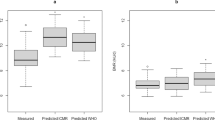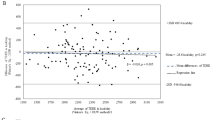Abstract
Objective: To measure daily energy expenditure (DEE) with indirect calorimetric facilities in sedentary and active subjects. To estimate daily energy needs with the FAO/WHO/UNU (1985) procedures (EDEE) and estimated energy requirement (EER) with the dietary reference intakes 2002 (DRI) in healthy adults with sedentary or high-activity conditions. To compare estimated daily energy needs with their measured values.
Design: Two groups of healthy subjects were tested under sedentary or high-activity conditions. In both groups, resting energy expenditure was measured after a 12-h overnight fast. DEE and basal metabolic rate (BMR) values were also measured with indirect calorimetry and compared to the relevant predicted values. Physical activity level and BMR were also estimated.
Subjects: A total of 45 sedentary (26 men and 19 women) and 69 active subjects (43 men and 26 women) aged 18–30 and 30–60 y.
Results: Measured daily energy expenditure (MDEE) was significantly lower than EDEE in sedentary men and women and in active men for the two age groups considered (P<0.05). EER was significantly lower than EDEE in both sedentary and active subjects of each subgroup (P<0.05).
Conclusions: The FAO/WHO/UNU (1985) procedures may overestimate daily energy needs, particularly in sedentary individuals. However, DRI (2002) are probably more adapted to estimate real daily energy needs in sedentary and active subjects in comparison to the FAO/WHO/UNU (1985) procedures.
This is a preview of subscription content, access via your institution
Access options
Subscribe to this journal
Receive 12 print issues and online access
$259.00 per year
only $21.58 per issue
Buy this article
- Purchase on Springer Link
- Instant access to full article PDF
Prices may be subject to local taxes which are calculated during checkout

Similar content being viewed by others
References
Behnke AR & Wilmore JH (1974): Evaluation and Regulation of Body Build and Composition. pp 20–37. Englewood Cliffs, NJ: Prentice-Hall.
Bouchard C, Tremblay A, Leblanc C, Lortie G, Savard R & Thériault G (1983): A method to assess energy expenditure in children and adults. Am. J. Clin. Nutr. 37, 461–467.
Canadian Fitness and Lifestyle Research Institute CFLRI (2000): Physical activity monitor, http://www.cflri.ca/cflri/pa/surveys/2000survey/2000survey.html.
Doucet E, St-Pierre S, Almeras N, Deprés J-P, Bouchard C & Tremblay A (2001a): Evidence for the existence of adaptive thermogenesis during weight loss. Br. J. Nutr. 85, 1–10.
Doucet E, Bouchard C & Tremblay A (2001b): Increased energy economy with aging. Obes. Res. 9 (Suppl 3), PG78 (abstract).
FAO/WHO/UNU (1985): Energy and Protein Requirements Report of a Joint Expert Consultation. WHO Technical Report Series, no 724. Geneva: WHO.
Food and Nutrition Board, the Institute of Medicine of the Nathional Academy of Sciences 2002: Dietary Reference Intakes for Energy, Carbohydrate, Fiber, Fat, Protein, and Amino Acids (Macronutrients). Washintong, DC: Nathional Academies Press.
Fukagawa NK, Bandini LG & Young JB (1990): Effect of age on body composition and resting metabolic rate. Am. J. Physiol. 259 (Endocrinol. Metab. 22), E233–E238.
Ingram DK. (2000): Age related decline in physical activity: generalizations to nonhumans. Med. Sci. Sports Exerc. 32, 1623–1628.
Klausen B, Toubro S & Astrup A (1997): Age and sex effects on energy expenditure. Am. J. Clin. Nutr. 65, 895–907.
Leibel RL, Rosenbaum M & Hirsch J (1995): Changes in energy expenditure resulting from altered body weight. New. Engl. J. Med. 332, 621–628.
Levine JA, Schleusner SJ & Jensen MD (2000): Energy expenditure of nonexercise activity. Am. J. Clin. Nutr. 72, 1451–1454.
Meneely EK & Kaltreider NL (1949): Volume of the lung determined by helium dilution. J. Clin. Invest. 28, 129–139.
Prentice AM, Black AE, Coward WA, Davies HL, Goldberg GR, Murgatroyd PR, Ashford J, Sawyer M & Whitehead RG (1986): High levels of energy expenditure in obese women. BMJ 292, 983–987.
Ravussin E, Lillioja S, Anderson TE, Chistin L & Bogardus C (1986): Determinants of 24-hour energy expenditure in man. Methods and results using a respiratory chamber. J. Clin. Invest. 78, 1568–1578.
Recommandations sur la nutrition, Sante et Bien-être Social Canada (1990) Rapport du comité de révision scientifique.
Ritz P (2001): Factors affecting energy and macronutrient requirements in elderly people. Pub. Health Nutr. 4, 561–568.
Sallis JS (2000): Age-related decline in physical activity: a synthesis of human and animal studies. Med. Sci. Sports Exerc. 32, 1598–1600.
Schofield WN (1985): Predicting basal metabolic rate, new standards and review of previous work. Hum. Nutr. Clin. Nutr. 39 (Suppl 1), S5–S41.
Snitker S, Tatarani PA & Ravussin E (2001): Spontaneous physical activity in a respiratory chamber is correlated to habitual physical activity. Int. J. Obes. Relat. Metab. Disord. 25, 1481–1486.
Speakman JR. (1998): The history and theory of the doubly labeled water technique. Am. J. Clin. Nutr. 68 (Suppl), S932–S938.
Tremblay A & Chiasson L (2002): Physical fitness in young college men and women. Can. J. Appl. Physiol. 27, 563–574.
White MD, Bouchard G, Buemann B, Alméras N, Despres J-P, Bochard C & Tremblay A (1996): Reproducibility of 24-h energy expenditure and macronutrient oxidation rates in an indirect calorimeter. J. Appl. Physiol. 80, 133–139.
Author information
Authors and Affiliations
Contributions
Contributors: This work was supported by the Canadian Institutes of Health Research. GA-G reviewed relevant literature, performed the statistical analyses, interpreted data, and drafted the manuscript. AT and CB were involved in the study design. ED and NA were involved in the data collection. They also revised the manuscript before publication.
Corresponding author
Rights and permissions
About this article
Cite this article
Alfonzo-González, G., Doucet, E., Alméras, N. et al. Estimation of daily energy needs with the FAO/WHO/UNU 1985 procedures in adults: comparison to whole-body indirect calorimetry measurements. Eur J Clin Nutr 58, 1125–1131 (2004). https://doi.org/10.1038/sj.ejcn.1601940
Received:
Revised:
Accepted:
Published:
Issue Date:
DOI: https://doi.org/10.1038/sj.ejcn.1601940
Keywords
This article is cited by
-
The impact of human and livestock respiration on CO2 emissions from 14 global cities
Carbon Balance and Management (2022)
-
Adaptive thermogenesis can make a difference in the ability of obese individuals to lose body weight
International Journal of Obesity (2013)
-
Basal metabolic rate of Brazilians living in the Southwestern United States
European Journal of Clinical Nutrition (2007)
-
Factorial estimation of daily energy expenditure using a simplified method was improved by adjustment for excess post-exercise oxygen consumption and thermic effect of food
European Journal of Clinical Nutrition (2006)
-
Reliability and validity of the combined heart rate and movement sensor Actiheart
European Journal of Clinical Nutrition (2005)



